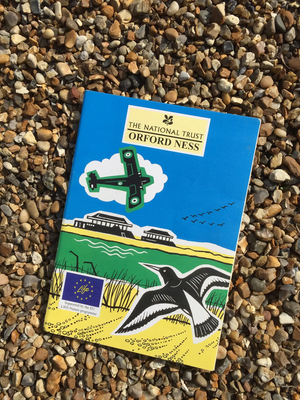Nature conservation, Orford Ness and the EU

In a booklet from 2003, the National Trust states that it is "a recognised fact that nature does not recognise or stop at national borders".
Since 1994 (after purchasing the site from the Ministry of Defence), the National Trust extensively renovated Orford Ness for nature conservation projects, much of the work being funded through the European Union LIFE-Nature programme. Because nature transcends borders, it was important to establish links and partnerships with other European conservation organisations, which the National Trust achieved through the EU LIFE-Nature project, so that information and advice could be shared more widely.
LIFE-Nature project work at Orford Ness has been funded in three stages:
- The aim of the LIFE 1 phase*, from 1994 to 1997, was to restore the "extensive but damaged coastal site and to conserve its outstanding physiographic interest; to encourage the breeding of a large number of wild birds (including EU Birds Directive Annex 1 species) and to increase the nature conservation value of its habitats". Work included "the re-creation and restoration of habitats by using livestock grazing as a management tool; improving water control on the marshes and controlling damaging activities such as illegal access and shooting", [...] "providing winter flooding of the grazing marshes for wildfowl and summer nesting and feeding areas for waders and other ground nesting birds", [...] and "preparing the site for public access after it having been a closed 'secret site' for eighty years".
- The aim of the LIFE 2 phase*, from 1997 to 2000, was to build on the earlier phase, to "improve the conservation status of EU Birds Directive Annex 1 species and other migratory species", and to "improve the status of habitats for which the site has been included as a candidate Special Area for Conservation designation". Work included "studies into factors affecting the breeding success of Annex 1 birds, principally predation, and effects of gull guano on the development of the rare shingle flora", [...] "the restoration of further areas of grazing marsh, including some river walls; creating 2 ha of new brackish water coastal lagoons with islands for breeding, feeding and overwintering waders and wildfowl and as increased habitat for the specialist lagoonal fauna found on the site; an experimental restoration of an area of degrade shingle; a continuing survey and monitoring programme and the development of public access and educational resources".
- A third round of funding (this time, LIFE+)** was awarded to the Alde-Ore estuary area for work between 2010 and 2014, with the National Trust working in partnership with the RSPB. This third project aimed to "establish functional, efficient and sustainable systems of water management to maintain and improve the quality of the coastal lagoons and marshes in response to increasingly lower rainfall", via a "network of new ditches, lagoons and water controls" and continuing monitoring of "species, water quality and levels to ensure these sites are fantastic areas for wildlife".
The LIFE programme is the EU's funding instrument for the environment and climate action, with LIFE-Nature particularly promoting "the conservation of natural habitats and the habitats of wild fauna and flora while taking into account the economic, social and cultural requirements and specific regional and local characteristics of each Member State".***
Sources:
* Orford Ness, The National Trust, 2003
** http://www.nationaltrust.org.uk/orford-ness-national-nature-reserve/features/life-projects-on-orford-ness [accessed 30 May 2016]